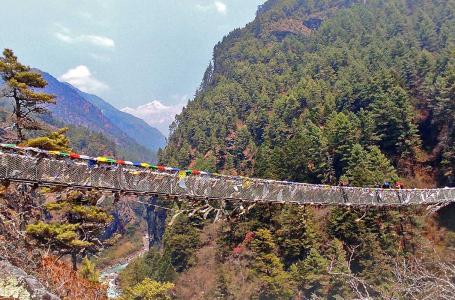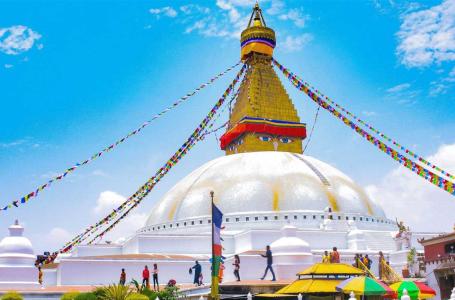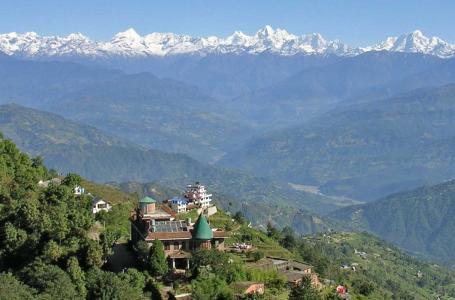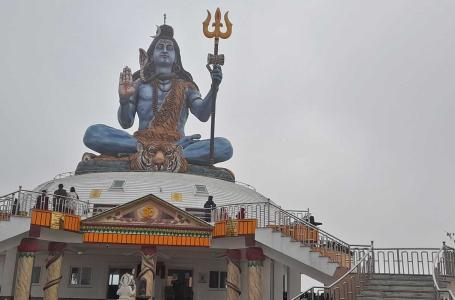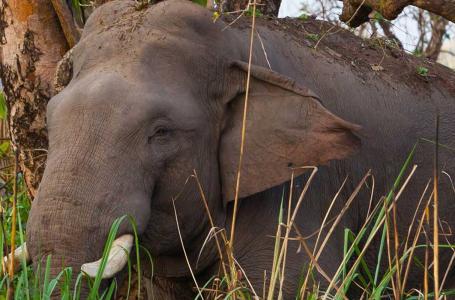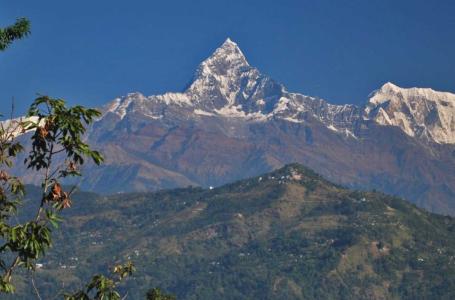Trip Highlights
Manaslu trekking offers a unique adventure, and our Manaslu Circuit Trek itinerary adds a special twist to the experience. By avoiding the usual routes and taking the higher highway to Salyankot, we have created a package that allows trekkers to enjoy a truly unique journey. However, we can customize the itinerary and services upon request. Considering the budget options, we have curated this Manaslu Trekking Guide Service. Instead of offering an all inclusive package, we offer guide-only service in this program. If you are looking for an all-inclusive program, please visit Manaslu Circuit Trek.
The Larkya La pass offers breathtaking mountain views, while the monasteries and historical sites add a spiritual and cultural dimension to the trek. Our itinerary includes new historical places and inspiring stories, making it a natural, cultural, and historical trekking package. Scroll below to learn more about the places and mountains on this extraordinary journey.
The Manaslu Circuit Trek requires careful planning due to its level of difficulty. To ensure a successful trek, it is essential to obtain permits, select the appropriate time of year, develop a detailed itinerary, consider hiring a local guide and porter, engage in physical training, acquire the necessary gear and equipment, create a comprehensive packing list, learn how to prevent altitude sickness, purchase travel insurance, ensure access to safe food and water, make arrangements for communication and emergency equipment, budget for expenses, and demonstrate responsibility. Safety and acclimatization are crucial for this challenging, high-altitude journey through the Himalayas.
This journey offers a remarkable display of colors and fragrances during the spring months of March to May. The weather remains consistent, with pleasant daytime temperatures. The blooming rhododendron woodlands create a stunning backdrop for your stroll. Typically, the clear skies allow for unobstructed views of the majestic peaks.
Autumn, spanning from September to November, presents another exceptional season.
This time follows the monsoon period and features dry, stable weather. The rains have rendered the pathways lush and vibrant, enhancing the beauty of the environment. The skies are consistently clear, providing breathtaking views of the mountains. The cool yet mild temperatures create ideal conditions for trekking.
The Manaslu Circuit Trek is not advisable during the monsoon or summer months of June, July, and August. Additionally, the winter chill from December to February can be intolerable for the average hiker.
Your meals and accommodations will be primarily provided by Teahouses or guesthouses along the Manaslu Circuit Trek. These lodgings offer a variety of options, ranging from basic rooms with shared facilities to more comfortable rooms with private bathrooms in certain areas. While the rooms may not be luxurious, they often come equipped with double beds, blankets, and heating stoves.
Teahouses along the Manaslu trail offer a diverse menu, including both international dishes and traditional Nepali cuisine such as Dal Bhat. In addition, you can find familiar foods like spaghetti, noodles, and pizza. Opting for vegetarian meals can help reduce the risk of food-borne illnesses. Bringing along snacks and energy bars for quick refueling on the go is also advisable. Don't forget to seek advice from your guide for better and more hygienic dining options.
The trek typically commences at Maccha Khola. The adventure starts in Kathmandu, where a public vehicle (shared Jeep) will transport you to Maccha Khola, taking approximately 9 to 10 hours, depending on the route and road conditions. Alternatively, you may opt for a private vehicle (4 hours), which is faster but not included in this package, thus incurring an additional cost. Our journey officially begins upon arrival at Machha Khola. From there, we will proceed on foot along the Manaslu Circuit Trek trail. As you traverse towards Lho, Samagaon, and other notable stops on the journey, you will pass through various villages, terraced fields, forests, and eventually higher altitudes.
Our expedition will conclude in Jomsom, where you can fly back to Pokhara or take a Jeep ride that will take 8 to 9 hours, depending on the road conditions.
The Nepali gove rules Manasalu Region, specifically between Jagat and Dharapani, we need two travelers from entering the area, requiring them to obtain entrance permits if they wish to visit. Furthermore, the government mandates that groups of hikers must always be accompanied by a local guide, with at least two hikers in each group. To facilitate conservation efforts and grant access to the restricted region, three different types of permits are necessary. Additionally, a TIMS permission may not required for this journey, which must be arranged through an authorized organization. It is important to note that freelance guides are not able to secure the appropriate permissions for the Manaslu Circuit.
Before entering the Manaslu region, you must first get a Manaslu Conservation Area Project (MCAP) Permit. In order to enter the Manaslu Conversation Area from Philim, you must have this permit.
Cost: Nrs 3000 per person. There are no restrictions or pricing changes based on the number of days spent inside MCAP.
2. Annapurna Conservation Area Project (ACAP Permit)
An ACAP Permit is required to enter Nepal's Annapurna Conservation Area (ACA) for trekkers and tourists. From Dharapani until the time you exit ACAP in Beshi Sahar, this permit is necessary as this trek includes some part of Annapurna Circuit Trek as well.
Cost: Nrs 3000 per person. There are no restrictions or pricing changes based on the number of days spent inside ACAP.
3. Special Restricted Area Permit for Manaslu (RAP)
The Nepalese government has granted the Restricted Area Permit (RAP) for Manaslu, a legal document that enables trekkers to enter and trek through particular restricted regions, including the Manaslu region. From Jagat to Sama Gaun, this Manaslu trek permit is necessary. You also need this permission to enter Tsum Valley.
Cost: USD 100 per person for the first seven days (September to November), plus an additional USD 15 per person per day starting on the eighth day. Whereas USD 75 per person for the first seven days (December to August) and an additional USD 10 per person per day commencing on the eighth day.
Passport-size photos -2p (For ACAP and MCAP permits)
One scanned photograph (to be uploaded for RAP's online form)
Photocopy of your passport (with at least six months validity)
Travel insurance papers (includes helicopter evacuation of up to 6000m)
Nepal tourist visa and original passport (required for Department of Immigration, Nepal)
We commence our Manaslu Circuit Trek with an early morning drive to Machhekhola in a Deluxe bus along the Trishuli River and Budi Gandaki River. This drive will pass through charming villages, and lush green valleys, and travel with local people. When we reach Machhekhola we can enjoy the views of the riverside. Stay overnight at the Lodge.
Out of two routes that leave from Machhakhola, we will choose the easier course and walk through the hallucinating trail, fenced by marijuana plants on both sides, until arriving at the Khorlabesi. From there, we will drop into the gorgeous ravine of Budhi Gandaki River and continue along the ancient yak caravan routes. The exotic large black rocks, sometimes overhanging, create a perfectly natural setting.
Soon, we will enter the Tatopani and venture across more exquisite waterfalls, cliffs, and farm fields before entering the village of Dovan. It is a nice village offering fleeting glimpses of the Manaslu and other anonymous ranges. We will continue our journey through the Yaruphant to arrive at the Jagat, where there is an entry checkpoint of the Manaslu Conservation Area Project (MCAP).
Our day starts by crossing a rocky bluff to the village of Salleri, a nice and quiet village of Manaslu. The trail then goes along the west side of the Budhi Gandaki River, with fabulous views of the Shringi Himal and the Langju Himal. We will then, cross the village of Sirdibas to make an appearance at the Ghatte Khola. We will pass by several Chortens and typical Buddhist monasteries before arriving at the prosperous-looking village of Philim.
From Philim, Deng is still 4-5 hours away. Through the isolated village of Ekle Bhatti (meaning one house), we will head up to the suspension bridge across the Budhi Gandaki river and pass through the sub-tropical forest leading to the Pewa village. A big and vibrant Kani gate, with the paintings of the few Buddhist deities, welcomes us to the village of Deng.
Phedi through the quaint village of Rana. But, you will never really know when you came and left the Bihi Phedi because the village itself is divided into three separate clusters of houses.
For the first few couples of hours, we will catch a steep ascend to Bihi Phedi and then drop to the Ghap along the zigzag trails. On the way, the rewarding monastery of Serang will entice us with the delicate paintings and carvings of several Buddhist deities- Guru Rinpoche, Sakyamuni Buddha, and Chenresig. There are beautiful Chortens to see and farm fields to pass by before arriving at the Ghap.
The surprises are still in stock. On the way to Namrung, we will walk through a pleasant forest of lichens and pines before entering into the serene village of Namrung. To describe Namrung in a phrase, we can call it a "Nepali version of Tibet" as you will get to witness the Tibetan cultures, rituals, and languages firsthand.
It is going to be a nice day today as you are about to venture across some of the exquisite villages and monasteries on the way.
First, we will pass by the farming village of Banjam, where vegetations are cultivated all around the year in the sloppy hills by forming terraces. Banjam also offers good views of the Ganesh Himal and other glaciers. We will continue to another nice village of Lihi, where there is a small monastery (almost always closed) and a three-leveled chorten painted by the images of several Buddhist deities.
Through the Hinang Monastery, we will proceed to the village of Sho, a place with a big prayer wheel. We will cross the river valley at Sho before showing off at Lho, which offers unparalleled views of the Manaslu ranges.
From Lho, the trail passes through the forest of alpine vegetation, which, in the past, used to be the ancient yak caravan routes for exchanging timber with Tibet. The fleeting glimpses of the ridge of the Ngadi Chuli will keep up its glorious magnetism throughout the walk. We will pass by several ancient monastery complexes- typically the Hongsangbu Monastery- which is a typical Tibetan monastery.
It takes 2 hours to reach Shyala and from there, the views are even more enticing. An icy river, which we will come across on the way, is a cool place to stay. About 45 minutes away, there is a junction leading to the Pungyen monastery. But we will continue the downhill section to Samagaon, without stopping by in the middle.
A day trip to Pungyen Gompa is worth of step you take.
First, we will retrace our steps back to the junction (as discussed in Day 6) and head northwest towards the Pungyen Gompa. A small Chorten on the way will encourage you to continue your journey until you see another small Chorten, of a similar kind. The ascent is relatively easier than the descent.
But, as we cross the 3rd Chorten, you will begin to feel the altitude pressure. It is when you should calm down and head up calmly. Himalchuli, Shringi Himal, Ngadi Chuli, and Manaslu are a few of the ranges that add flavor to the journey during the ascent. There is also a small pasture, on the way, that shows another trail to the top of the hill. It is worth going up the hill to witness the green lake of Pungyen Tal and a few of the dead glaciers on its side.
By the time we arrive at the Pungyen Gompa, we will check out its periphery and the arts around it. This monastery is in itself a representation of a typical Buddhist monastery of the Kagya-pa sect. The surrounding views of the glaciers are truly astonishing.
This is another interesting day in the Manaslu region but be aware of the altitude. The more you ascend to Samdo, the more you feel the effects of the altitude. It is better to slow down your pace and head calmly.
From Samagaon, Birendra Tal is not very far away. It is a glacial lake that appears turquoise in color because of the decomposition of the glacial matter at the bottom of the lake. The name of the lake, ‘Birendra', comes from the name of the late king Birendra Bir Bikram Shah Dev, who visited this lake at some time in history.
The path is interesting as it goes through the snowy sections of the Himalayas. Skip the trail that goes to the Manaslu Base Camp and proceeds by the side of the Mani walls, overlooking the beautiful Samdo Peak, until you arrive at Samdo.
Note: If you are feeling the effects of the altitude then, it is better to stop-by for one day here before climbing up to the Dharamsala.
While heading to the Dharamsala (Larkya Phedi), you need to be aware of your breathing because nobody knows when the altitude demon will wake up to attack you. The path is mostly ascent until the Dharamsala.
First, we will pass by the ancient market of Larkya Bazaar and then head up to the Larkya Phedi along the fabulous trail, marked by chortens and mani walls. The path sometimes goes through the juniper bushes and other astounding glaciers before again joined the exposed trail.
When we reach the Larkya Phedi, we will prepare for the next day. Before heading towards the pass, make sure you are fully acclimatized.
This day is what we have been waiting for so long. Pack up enough food and drinks (must) before heading to the Larkya La pass because it will require you to be strong.
From the beginning of the trek, the mountains and glaciers start to show off. It is when you feel like you are climbing up the mountain. As you walk over the moraine, the side view of the Larkya glacier appears stunning. There are also Chortens and prayer flags, wrapped around the large stones. It is to avoid the evil spirits and demons from the past.
By the time we reach the top of the pass, we can capture the stunning views of the North of Manaslu, Syacha glacier, green lakes and several astounding naturally designed icy architectures. The snowfields of Kang Guru and the snowy spires of Annapurna ranges are the magnet of this high pass. Because of the altitude, it is not recommended to stay here for long; so, we will continue down to the Bimthang without a much delay.
Even after descending from the rewarding pass of Larkya La, the views are still sensational at this point. The difference in the views from the Larkya La Pass and the trail to Tilje is the proximity of the mountains. Otherwise, there is no difference at all.
We will continue down the pleasant forest of rhododendrons, pine, oak, and birch, overlooking the stunning peaks and glaciers of the Manaslu. Larkya glacier and the north face of the Manaslu appear prominent at this point. Most parts of the trail are through the forest, so we will again join the forest trail and cross a suspension bridge, spanning across the Dudh Khola River. The icy buttresses of the Kang Guru are still impressive at this point.
We will go down the Yak Kharka to arrive at the Tilje.
Although the trek to Tal from Tilje doesn't accompany any wow glimpses of the mountains, the walk is still pleasant. The greenery starts to fill your eyes and the warmth of the lower altitude feels unique. The vegetation start to change from alpine to sub-tropical and the villages start to grow dense and vibrant.
Through the wonderful village of Dharapani, we will enter into the village of Tal, meaning Lake. The lodges in Tal are very much intoxicating.
From Tal, we will descend to the Besisahar on foot and catch a long drive to Kathmandu. The route is the same as we have ventured on earlier.
Trip Start and End Point
Kathmandu / Kathmandu
| DATES | STATUS | PRICE | SPACE LEFT | ||||
|---|---|---|---|---|---|---|---|
|
Start date: 25-Apr, 2025
End date: 07-May, 2025 |
Guaranteed | USD 555 |
2
|
Book Now | |||
|
Start date: 05-May, 2025
End date: 17-May, 2025 |
Guaranteed | USD 555 |
2
|
Book Now | |||
|
Start date: 25-Aug, 2025
End date: 06-Sep, 2025 |
Guaranteed | USD 555 |
2
|
Book Now | |||
|
Start date: 29-Aug, 2025
End date: 10-Sep, 2025 |
Guaranteed | USD 555 |
2
|
Book Now | |||
|
Start date: 07-Sep, 2025
End date: 19-Sep, 2025 |
Guaranteed | USD 555 |
2
|
Book Now | |||
|
Start date: 10-Oct, 2025
End date: 22-Oct, 2025 |
Guaranteed | USD 555 |
2
|
Book Now | |||
|
Start date: 05-Nov, 2025
End date: 17-Nov, 2025 |
Guaranteed | USD 555 |
2
|
Book Now | |||
|
Start date: 03-Dec, 2025
End date: 15-Dec, 2025 |
Guaranteed | USD 555 |
2
|
Book Now | |||
Yes. Since the Manaslu region is a restricted area, all trekkers must hire a licensed guide and travel with at least one other trekker to obtain permits.
A guide ensures safe navigation through remote trails, helps with altitude management, arranges accommodation, and provides cultural insights about the villages, monasteries, and local traditions.
Yes, if needed, a guide can arrange a porter to carry your luggage (typically 20-25 kg per porter), allowing you to trek comfortably.
Most guides speak English, but you can also find those fluent in French, Spanish, German, and other languages, depending on availability.
Manaslu Circuit guides are typically well-trained, government-certified, and have years of experience leading treks in high-altitude, restricted regions. Many also have first-aid and altitude sickness training.

